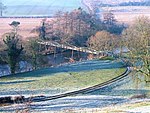All Saints Church, Sockburn
Church of England church buildings in EnglandGrade I listed buildings in County Durham

All Saints Church is a ruined Church of England parish church in Sockburn, County Durham, England. A Grade I listed building, the church has pre- and post-Conquest mediaeval aspects, and is linked to the legends of the Sockburn Worm.
Excerpt from the Wikipedia article All Saints Church, Sockburn (License: CC BY-SA 3.0, Authors, Images).All Saints Church, Sockburn
Sockburn Lane,
Geographical coordinates (GPS) Address Nearby Places Show on map
Geographical coordinates (GPS)
| Latitude | Longitude |
|---|---|
| N 54.4582 ° | E -1.4619 ° |
Address
Sockburn Hall
Sockburn Lane
DL2 1PH
England, United Kingdom
Open on Google Maps









